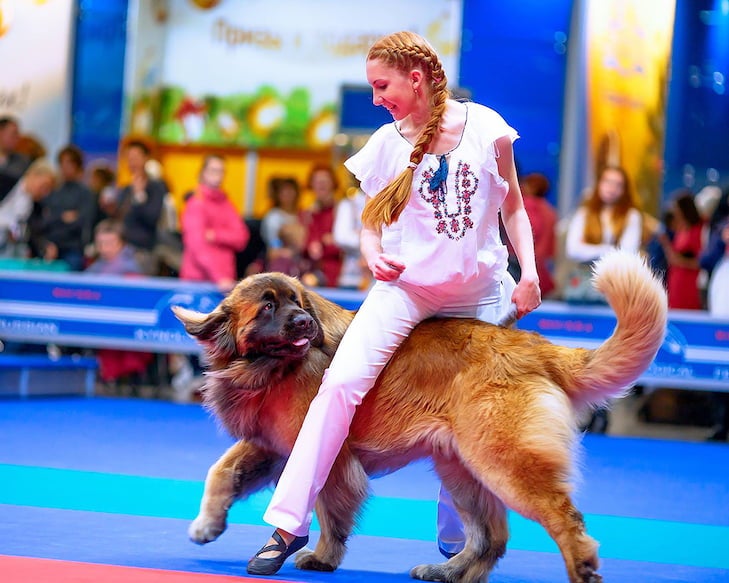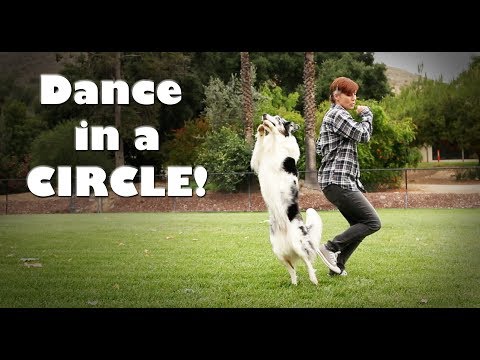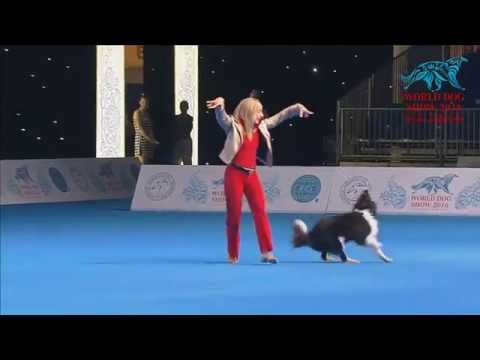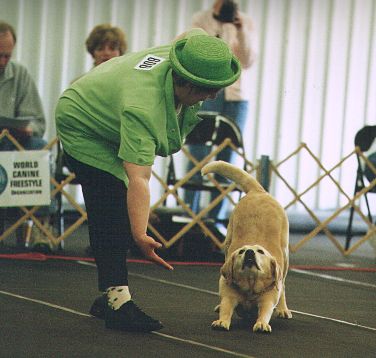Step into the enchanting realm of Canine Freestyle Dancing and witness the mesmerizing bond between Border Collies and their human partners. This captivating art form combines the agility of these remarkable dogs with the creativity and coordination of their owners, resulting in a mesmerizing display of synchronized movements and expressive choreography. From perfectly timed spins to graceful leaps, the world of Canine Freestyle Dancing opens up a world where music, movement, and the unconditional love between human and canine come together in perfect harmony. Discover the magical world of Canine Freestyle Dancing and be captivated by the beauty and artistry that unfolds before your eyes.
History of Canine Freestyle Dancing
Canine Freestyle Dancing, also known as dog dancing or musical canine freestyle, is a relatively new and innovative dog sport that combines the elements of dog training, obedience, and dance. It all began in the late 1980s when a few dog trainers and owners started to incorporate dance moves into their obedience routines. What began as a fun and creative way to enhance their dogs’ performance quickly evolved into a full-fledged sport with its own set of rules and competitions.
Origins of Canine Freestyle
The exact origins of Canine Freestyle are difficult to pinpoint, as it was the collective effort of many dog trainers and enthusiasts who sparked its creation. However, the sport gained significant traction in the United States and Canada during the early 1990s, thanks to influential trainers like Carolien Coile and Richard Curtis. They introduced the concept of incorporating choreographed dance routines and synchronized moves into traditional obedience exercises, setting the stage for the birth of Canine Freestyle as we know it today.
Evolution of Canine Freestyle
As Canine Freestyle gained popularity, more and more dog trainers and owners began exploring its possibilities. The sport quickly evolved, with participants pushing the boundaries of choreography and creativity. From simple routines to complex, synchronized performances set to music, Canine Freestyle became a true art form that showcased the unique bond between dogs and their human partners. Today, Canine Freestyle has expanded beyond obedience events, with its own dedicated competitions and a growing community of passionate enthusiasts worldwide.
Popularity and Recognition
Over the years, Canine Freestyle has captured the hearts of dog lovers around the globe. Its unique blend of obedience, dance, and creativity has contributed to its growing popularity as a fun and engaging dog sport. In addition to its avid following among dog enthusiasts, Canine Freestyle has also gained recognition from various dog organizations and federations. For example, the World Canine Freestyle Organization (WCFO) and the Musical Dog Sport Association (MDSA) both provide platforms for Canine Freestyle enthusiasts to compete, showcase their skills, and receive recognition for their talents.
Training and Skills Required
Participating in Canine Freestyle requires a combination of training, skills, and coordination from both the dog and their human partner. Here are some of the key areas of focus when preparing for Canine Freestyle:
Basic Obedience Training
Before diving into the world of Canine Freestyle, it is crucial to establish a solid foundation of basic obedience training for your dog. This includes commands like sit, stay, heel, and recall. Dogs must be responsive to their handler’s cues and able to maintain focus in different environments. By ensuring your dog has mastered these fundamental skills, you’ll have a solid base from which to build upon for more complex dance routines.
Musicality and Choreography
To excel in Canine Freestyle, you and your dog must develop a sense of musicality and rhythm. It’s important to choose music that complements your dog’s movements and showcases their unique skills and personality. Choreography plays a significant role in Canine Freestyle, as it involves planning and arranging various moves and sequences to create a visually appealing routine that harmonizes with the chosen music. Working with a trainer or attending Canine Freestyle classes can help you develop your skills in musicality and choreography.
Trick Training
In Canine Freestyle, incorporating tricks and unique moves adds flair and entertainment value to your routine. Trick training involves teaching your dog a wide range of fun and impressive tricks, such as spinning, jumping, rolling over, and weaving between your legs. These tricks can be seamlessly integrated into your dance routine, adding excitement and captivation for both the audience and the judges.
Coordination and Agility
Canine Freestyle requires precise coordination between you and your dog. You’ll need to establish clear communication and cues to ensure smooth transitions between moves and maintain synchronization throughout the routine. Additionally, both you and your dog should possess a certain level of agility to execute the various dance steps and movements with ease. Regular practice and conditioning exercises can enhance your coordination and agility as a team.

Choosing the Right Breed
While Canine Freestyle is open to all breeds and mixes, certain breeds tend to excel in this sport due to their natural abilities and aptitude for learning. Here are a few breeds known for their affinity towards Canine Freestyle:
Border Collies and Canine Freestyle
Border Collies are often regarded as one of the most versatile and intelligent breeds when it comes to dog sports, including Canine Freestyle. Their natural herding instincts, high energy levels, and eagerness to please make them well-suited for the precision and demanding movements involved in Canine Freestyle routines. Border Collies thrive on mental and physical stimulation, making them highly trainable and adaptable to the choreography and intricacies of the sport.
Other Breeds Suitable for Canine Freestyle
While Border Collies may excel in Canine Freestyle, they are by no means the only breed capable of participating in this sport. Many different breeds, including Golden Retrievers, Australian Shepherds, Poodles, Shetland Sheepdogs, and even smaller breeds like Jack Russell Terriers, have shown great aptitude and enthusiasm for Canine Freestyle. It ultimately comes down to the individual dog’s temperament, willingness to learn, and the owner’s commitment to training and practicing.
Equipment and Costumes
Canine Freestyle requires minimal equipment, but having the right gear and attire can enhance both the performance and overall experience. Here are a few considerations for equipment and costumes in Canine Freestyle:
Appropriate Dance Attire for Dogs
While not mandatory, many Canine Freestyle enthusiasts enjoy dressing up their dogs in costumes or outfits that reflect the theme or mood of their routine. This can range from simple accessories, like bows or bandanas, to more elaborate costumes that include hats, tutus, or even custom-made outfits. It’s important to ensure that any clothing or accessories chosen for your dog are safe, comfortable, and do not restrict their movement or impede their performance.
Recommended Equipment and Props
In terms of equipment, there are a few standard items that are commonly used in Canine Freestyle. These include:
- A comfortable and well-fitted harness or collar for your dog, ensuring both comfort and security during the routine.
- A sturdy and non-slippery surface to perform on, such as a dance mat or rubberized flooring, which provides traction and reduces the risk of injury.
- Props and objects that can be integrated into your routine, such as hoops, cones, or small platforms, to add visual interest and variety to your dance moves.
It’s important to note that the equipment and costumes you choose should not hinder your dog’s movements or pose any potential danger during their performance.

Benefits of Canine Freestyle Dancing
Engaging in Canine Freestyle offers numerous benefits for both you and your dog. Beyond the sheer joy and entertainment value, here are some of the key advantages of participating in this unique sport:
Physical Exercise and Fitness
Canine Freestyle involves a significant amount of physical exercise for both dogs and their human partners. The intricate dance routines, jumps, spins, and agility moves provide a fun and engaging workout that helps promote overall fitness and cardiovascular health. Regular participation in Canine Freestyle can contribute to weight management, muscle tone, and improved stamina for both you and your furry companion.
Bonding and Relationship Building
The foundation of Canine Freestyle lies in the strong bond and partnership between you and your dog. Through training and practicing together, the trust and connection between you and your four-legged companion deepen. The shared experience of learning and performing complex routines fosters a sense of teamwork and strengthens the bond between you. Canine Freestyle offers a unique opportunity to enhance the relationship with your dog and create lasting memories.
Mental Stimulation and Confidence Building
Canine Freestyle requires dogs to think and respond to a variety of cues and commands accurately. This mental stimulation can help keep their minds sharp and active, preventing boredom and behavioral issues. Moreover, the challenges and accomplishments involved in Canine Freestyle can boost your dog’s confidence and self-esteem. By mastering new moves and successfully executing complex routines, dogs gain a sense of accomplishment and pride in their abilities.
Competitions and Performances
For those looking to take their Canine Freestyle journey to the next level, there are various opportunities to compete and showcase their skills. Here are some important aspects of Canine Freestyle competitions:
Major Canine Freestyle Competitions
Several prestigious Canine Freestyle competitions are held worldwide, attracting talented teams from different countries. The Dog Dance World Championship organized by the World Canine Freestyle Organization (WCFO) is one of the most renowned competitions in the field. Other notable events include the Canine Freestyle Federation (CFF) Championships and the Musical Dog Sport Association (MDSA) Canine Freestyle Championships. These competitions provide a platform for participants to demonstrate their creativity, choreography, and connection with their dogs.
Judging Criteria
In Canine Freestyle competitions, judges evaluate numerous aspects of the performance, including:
- Musical Interpretation: How well the routine matches the music’s tempo, mood, and rhythm.
- Choreography: The complexity and variety of the dance moves, transitions, and formations.
- Precision and Synchronization: The accuracy and coordination between you and your dog throughout the routine.
- Originality and Creativity: The incorporation of unique and innovative elements that set the routine apart.
- Interpretation of Dance Styles: The ability to convey different dance styles, such as ballet, hip-hop, or Latin, through the routine.
Judges provide feedback and scores based on these criteria, determining the final standings and winners of the competition.
Famous Canine Freestyle Performers
Over the years, Canine Freestyle has garnered a following of talented and renowned performers. One such notable team is Carolyn Scott and her Border Collie, Rookie. Known as the “Dynamic Duo,” Carolyn and Rookie have captivated audiences worldwide with their high-energy routines and impressive dance moves. Other famous Canine Freestyle performers include Richard Curtis and his Border Collie, Otter, and Sara Carson and her Border Collie, Hero, who gained fame on America’s Got Talent.

Safety and Precautions
While Canine Freestyle is generally a safe and enjoyable activity for dogs, it’s essential to prioritize safety and take necessary precautions to ensure the well-being of both you and your furry partner. Here are some aspects to consider:
Injury Prevention
To minimize the risk of injuries, it’s crucial to start slowly and gradually build up your dog’s stamina and physical abilities. Overexertion can lead to strains or sprains, so it’s important to recognize your dog’s limits and provide adequate rest and recovery time. Additionally, using proper form and implementing safe techniques during jumps and other high-impact moves can help prevent injuries.
Proper Warm-up and Cool-down
Just like any physical activity, warming up your dog’s muscles before engaging in Canine Freestyle is essential. Light exercises, such as stretching and a gentle walk, can help prepare the body for more intense movements. A cool-down period after the routine is equally important to allow the muscles to relax and reduce the risk of stiffness or soreness. Consult with your veterinarian or a professional trainer to develop a suitable warm-up and cool-down routine for your dog.
Health Considerations
Before embarking on your Canine Freestyle journey, it’s recommended to ensure that your dog is in good overall health. Regular visits to the veterinarian for check-ups and vaccinations are critical. Additionally, pay attention to any signs of discomfort, pain, or fatigue during the training or performance. Being proactive in maintaining your dog’s health and well-being will contribute to their longevity and enjoyment in the world of Canine Freestyle.
Canine Freestyle and Therapy Work
Beyond its role as a competitive dog sport, Canine Freestyle has found a place in the field of therapy work. The unique combination of movement, music, and human-canine connection makes Canine Freestyle an excellent therapeutic activity for both therapy dogs and individuals in need. Here are some key benefits of Canine Freestyle in a therapeutic context:
Canine Freestyle as a Therapeutic Activity
Canine Freestyle provides a source of emotional support and comfort to individuals facing physical, cognitive, or emotional challenges. The harmonious movements and music can have a calming and uplifting effect on participants, boosting their mood and reducing stress and anxiety. For therapy dogs, engaging in Canine Freestyle can be a rewarding experience as they bring joy and happiness to those they visit.
Benefits for Therapy Dogs and Individuals
Therapy dogs involved in Canine Freestyle gain opportunities for socialization, mental stimulation, and an avenue to express their natural talents. The interaction with individuals during performances or therapy sessions helps them develop a bond and establish trust. For individuals receiving therapy, Canine Freestyle offers an enjoyable and engaging form of therapy that can enhance their physical, emotional, and cognitive well-being. The joy and connection experienced through Canine Freestyle can uplift spirits and provide a sense of accomplishment.

Frequently Asked Questions
Here are answers to some common questions about Canine Freestyle:
What is Canine Freestyle Dancing?
Canine Freestyle Dancing is a dog sport that combines elements of obedience, dance, and choreography, set to music. Dogs and their human partners perform synchronized routines that showcase their bond, skills, and creativity.
Is Canine Freestyle suitable for all dogs?
Yes, Canine Freestyle is open to all breeds and mixed breeds. While certain breeds may have a predisposition to excel, any dog with the right temperament, willingness to learn, and owner commitment can participate in Canine Freestyle.
Do I need to be a professional dancer to participate?
No, you do not need to be a professional dancer to participate in Canine Freestyle. While some dance experience may be beneficial, the focus is more on the teamwork, coordination, and creativity between you and your dog.
How can I get started in Canine Freestyle?
To get started in Canine Freestyle, consider attending classes or workshops led by experienced trainers who specialize in the sport. They can provide guidance, teach fundamental skills, and help you and your dog develop a solid foundation for future routines. Additionally, watching performances and competitions online or in person can inspire and provide ideas for your own routines.
Conclusion
Canine Freestyle Dancing offers a captivating and unique way to showcase the bond and talents shared between dogs and their human partners. From its humble beginnings to its evolution as a recognized sport worldwide, Canine Freestyle continues to captivate audiences with its blend of obedience, dance, and creativity. Whether you choose to compete, perform, or simply enjoy the experience with your dog, Canine Freestyle provides countless opportunities for enrichment, bonding, and the celebration of the magical partnership between humans and canines. So put on your dancing shoes and explore the joyful world of Canine Freestyle Dancing!

